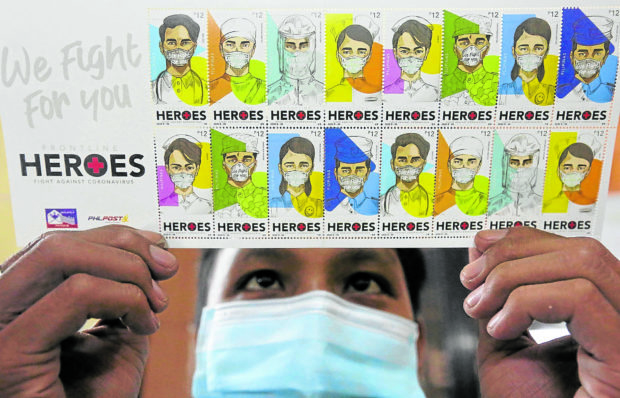DOH reports biggest single-day jump in COVID-19 deaths

COLLECTORS’ ITEM A Post Office worker shows off a sheet of new PhilPost stamps featuring front-liners, including health workers, policemen, soldiers, as well as delivery, food and supermarket personnel who are serving Filipinos through the pandemic.A regular stamp sells for P12 and a sheet P192. —MARIANNE BERMUDEZ
MANILA, Philippines — The Department of Health (DOH) on Monday reported the country’s biggest single-day jump in COVID-19 deaths and warned of further infections and fatalities unless Filipinos learned to live with the new coronavirus.
Health Undersecretary Maria Rosario Vergeire belatedly reported 162 new deaths recorded on Sunday, the biggest daily jump documented in Southeast Asia to date, and announced 2,124 new infections.
The Sunday report was delayed due in part to the DOH’s efforts to reconcile and improve its data management system.
More than tripled since June
The new infections brought the national total to 56,259, of which 38,676 were active cases.
Article continues after this advertisementVergeire said the 162 deaths, which increased the toll to 1,534, did not happen in July alone. More than half of them, or 90, occurred in June, while 51 were recorded in July. The 20 other deaths happened in May, while one was in April.
Article continues after this advertisementVergeire said 2,009 more patients had recovered, raising the total number of COVID-19 survivors to 16,046.
The total of coronavirus infections has more than tripled since June 1 when the government began easing stringent lockdown restrictions, including allowing public transport, restaurants and shopping malls to reopen at limited capacities to restart the economy.
Vergeire blamed the surge in infections on Filipinos’ failure to comply with minimum public health standards following the relaxation of the restrictions.
She said no amount of governmental and medical intervention would be enough to curb the spread of the virus if the people would not do their part by changing their behavior.
“If the people don’t make it harder for the virus to spread, no amount of testing, tracing and isolation will save us. If we don’t change our behavior, even if we have a lot [of resources for] testing and are able to trace all contacts, the number of infections will still rise,” she told reporters. “We will not be able to completely beat it without the people learning to live with the virus.”
The DOH said it expected the number of fatalities to rise further, with nearly 12,000 suspected positive cases yet to be verified.
“As part of ongoing data harmonization, we cannot avoid seeing cases not yet included in our official death count,” Vergeire said.
The health department said it was looking into whether patients who had quarantined at home did so properly so that it could better understand if this may have been a factor in the surge of coronavirus cases.
Vergeire said that while there were a number of factors that could contribute to community transmission of the virus, the DOH was not discounting yet the possibility that patients quarantining at home may have also helped drive up infections.
“When we speak of transmission in communities, there might be a lot of factors that are being considered. So that’s one, but we are also looking at other factors because that’s not the only thing that could drive infection in communities,” she said.
As of Saturday, there were 12,684 suspect and probable COVID-19 cases on home quarantine. Latest DOH data last week showed there were more than 11,000 confirmed cases quarantining at home.
Cabinet Secretary Karlo Nograles said on Sunday that the Inter-Agency Task Force for the Management of Emerging Infectious Diseases was now discouraging home quarantine for mild and asymptomatic COVID-19 cases because it could lead to the spread of the virus to members of the patients’ families.
Clarification
But Vergeire clarified on Monday that the DOH was not discouraging patients from home quarantining, but they should meet certain conditions to avoid spreading the virus.
She said that apart from having their own room, patients on home quarantine should not interact with their family. They should also be monitored by barangay health workers.
The task force, she said, asked Metro Manila mayors to ensure that patients quarantining at home were properly monitored and referred to temporary treatment centers if they couldn’t strictly follow quarantine measures in their homes.
Later on Monday, the DOH reported 836 new infections, pushing the national tally to 57,006.
The additional cases, however, were only from 57 of the 82 accredited laboratories. Of the new cases, 749 were patients who tested positive for the coronavirus in the last three days, while 87 were confirmed to have been infected four days ago or earlier.
The DOH recorded 4,325 more recoveries, increasing the total number of survivors to 20,371. It said 65 patients had died, raising the death toll to 1,599.
Of the newly reported deaths, only nine died in July. Most of the deaths, or 54, occurred in June, while two were recorded in May. Nearly all of the deaths, or 59, were in Central Visayas.
—With a report from the wires